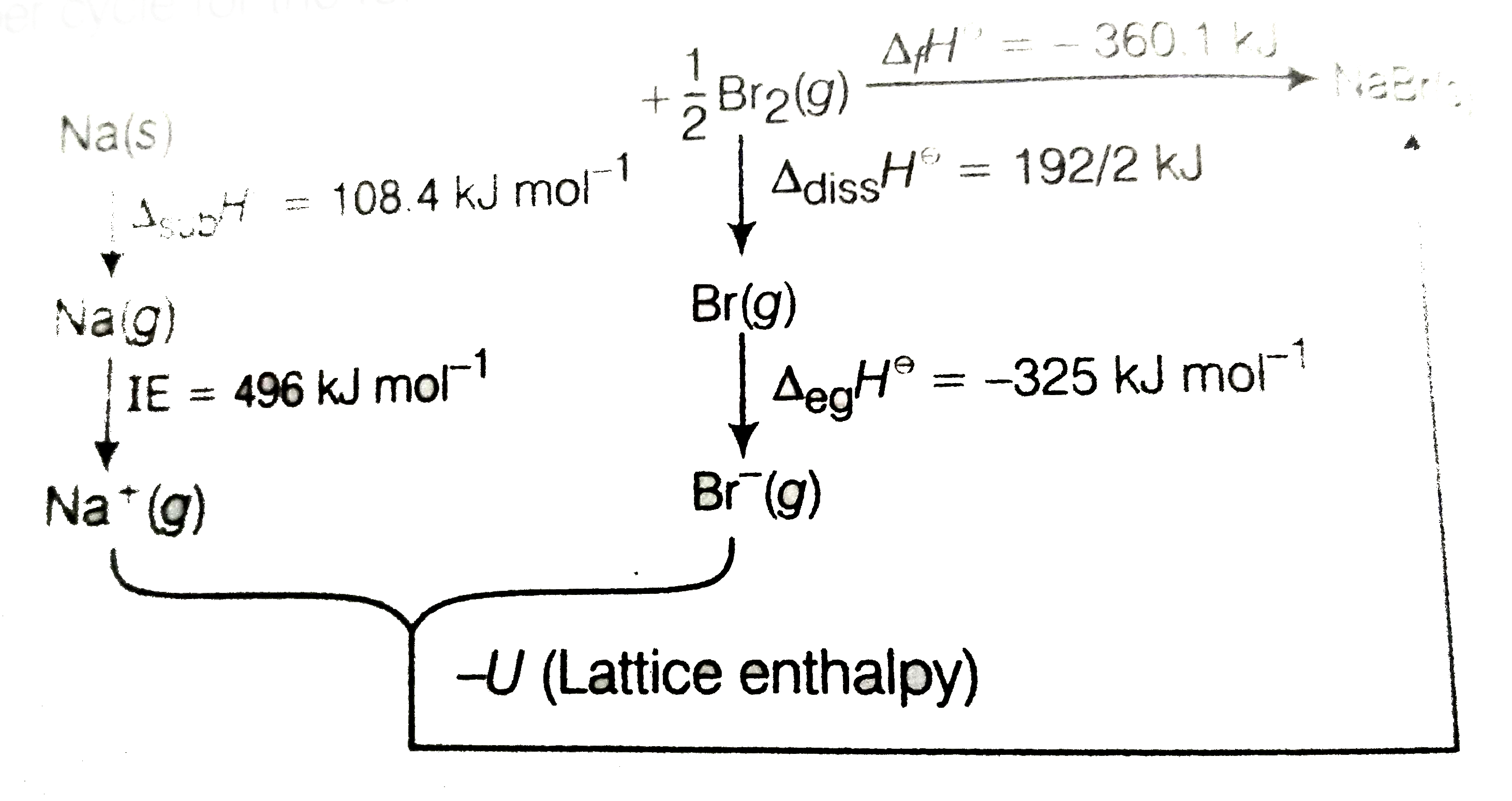Use the following data to calculate ΔlatticeH∘ for NaBr. ΔsubH∘ for sodium metal =108.4kJmol−1, ionization enthalpy of sodium =496kJmol−1., electron gain enthalpy of bromine =−325kJmol−1 bond dissociation enthalpy of bromine =192kJmol−1,ΔfH∘ for NaBr(s)−360kJmol−1.
Given that, ΔsubHΘ for Na metal =108.4kJmol−1
IE of Na=496kJmol−1 of Br=−325kJmol−1,ΔdissHΘ of Br=192kJmol−1,ΔfHΘ for NaBr=−360.1kJmol−1
Born-Haber cycle for the fomation of NaBr is as

By applying Hess's law,
ΔfHΘ+IE+ΔdissHΘ+ΔegHΘ+U
−360.1=108.4+496+96+(−325)−U
U=+735.5kJmol−1
Topper's Solved these Questions
Similar Questions
Use the following data to calculate ΔlatticeH∘ for NaBr. ΔsubH∘ for sodium metal =108.4kJmol−1, ionization enthalpy of sodium =496kJmol−1., electron gain enthalpy of bromine =−325kJmol−1 bond dissociation enthalpy of bromine =192kJmol−1,ΔfH∘ for NaBr(s)−360kJmol−1.
View SolutionUse the following data to calculate ΔlatticeH∘ for NaBr. ΔsubH∘ for sodium metal = 108.4kJmol−1.Ionization enthalpy of sodium = 496kJmol−1 Electron gain enthalpy of bromine = −325kJmol−1.Bond dissociation enthalpy of bromine = 192 kJ mol−1. ΔH∘f for NaBr (s) = −360.1kJmol−1.
View Solution
Knowledge Check
- Question 1 - Select One
use the following data to calculate Δ latticeH∘forNaBr.Δ(sub)H− fpr sodium metal =108.4kJmol−1
lonisation enthaply of sodium =496kJmol−1 ltbr gt Electron gain enthalpy of bromine =325kJmol−1
bond dissociation enthalpy of bromine =192kJmol−1
ΔtH−forNaBr(s)=−360.1kJmol−1A−735.5kJmol−1B+735.5kJmol−1C−789.89JK−1mol−1D+735.5Jmol−1 - Question 2 - Select One
For Br2(l) Enthalpy of atomisation = x kJ/mol, Bond dissociation enthalpy of bromine = y kJ/mole, then
Ax>yBx<yCx=yDRelation does not exist - Question 3 - Select One
The enthalpy of solution of sodium chloride is 4kJmol−1 and its enthalpy of hydration of ion is −784kJmol−1. Then the lattice enthalpy of NaCl (in kJmol−1) is
A+788B+4C+398D+780
Use the following data to calculate ΔlatticeH∘ for NaBr. ΔsubH∘ for sodium metal = 108.4kJmol−1.Ionization enthalpy of sodium = 496kJmol−1 Electron gain enthalpy of bromine = −325kJmol−1.Bond dissociation enthalpy of bromine = 192 kJ mol−1. ΔH∘f for NaBr (s) = −360.1kJmol−1.
View SolutionLattice energy of NaCl(s) is -790 kJ mol−1 and enthalpy of hydration is -785 kJ mol−1. Calculate enthalpy of solution of NaCl(s).
View Solutionthe bond enthalpy of H2(g) is 436 kJmol−1 and that of N2(g) is 941.3 kJmol−1. Calculate the average bond enthalpy of ann N-H bond in ammonia, Δ∘t(NH3)=−46kJmol−1
View SolutionThe enthalpy of solution of sodium chloride is 4kJmol−1 and its enthalpy of hydration of ion is −784kJmol−1. Then the lattice enthalpy of NaCl (in kJmol−1) is
View SolutionThe enthalpy of solution of sodium chloride is 4kJmol−1 and its enthalpy of hydration of ion is −784kJmol−1. Then the lattice enthalpy of NaCl (in kJmol−1) is
View Solution

